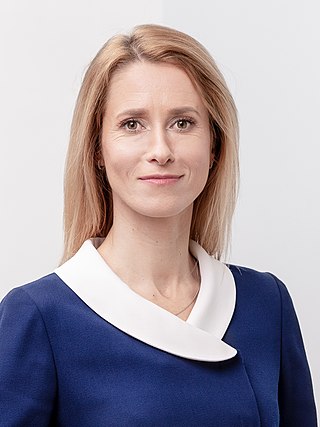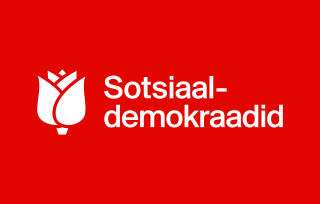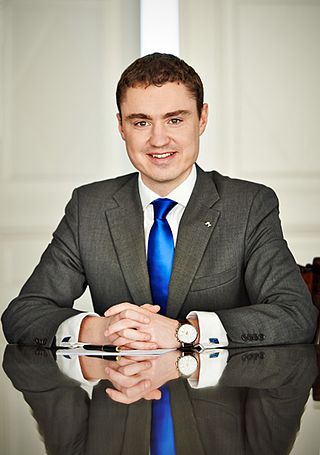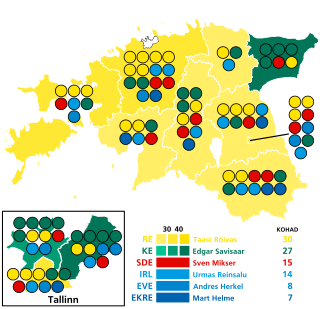
The Estonian Centre Party is a populist political party in Estonia. It was founded in 1991 as a direct successor of the Popular Front of Estonia, and it is currently led by Jüri Ratas.

The People's Union of Estonia was a political party in Estonia. Its last leader was Margo Miljand.

The Estonian Reform Party is a liberal political party in Estonia. The party has been led by Kaja Kallas since 2018. It is colloquially known as the "Squirrel Party".

The prime minister of Estonia is the head of government of the Republic of Estonia. The prime minister is nominated by the president after appropriate consultations with the parliamentary factions and confirmed by the parliament (Riigikogu). In case of disagreement, the Parliament can reject the president's nomination and choose their own candidate. In practice, since the prime minister must maintain the confidence of Parliament in order to remain in office, they are usually the leader of the senior partner in the governing coalition. The current prime minister is Kaja Kallas of the Reform Party. She took the office on 26 January 2021 following the resignation of Jüri Ratas.

The Social Democratic Party is a centre-left political party in Estonia. It is currently led by Lauri Läänemets. The party was formerly known as the Moderate People's Party. The SDE has been a member of the Party of European Socialists since 16 May 2003 and was a member of the Socialist International from November 1990 to 2017. It is orientated towards the principles of social-democracy, and it supports Estonia's membership in the European Union. From April 2023, the party has been a junior coalition partner in the third Kallas government.
The Pro Patria Union was a national-conservative political party in Estonia. The party was founded on 2 December 1995 from a merger of the Estonian National Independence Party and the Pro Patria National Coalition.

Andrus Ansip is an Estonian politician, a member of the European Parliament, the former European Commissioner for Digital Single Market and Vice President of the European Commission, in office from 2014 until 2019. Previously, he was Prime Minister of Estonia from 2005 to 2014 and chairman of the liberal Estonian Reform Party from 2004 to 2014.
Andrus Ansip is the former Prime Minister of Estonia who formed three consecutive cabinets.

Parliamentary elections were held in Estonia on 4 March 2007. The newly elected 101 members of the 11th Riigikogu assembled at Toompea Castle in Tallinn within ten days of the election. It was the world's first nationwide vote where part of the voting was carried out in the form of remote electronic voting via the internet.

Isamaa is a Christian-democratic and national-conservative political party in Estonia.

Urmas Reinsalu is an Estonian politician who served as Minister of Foreign Affairs from 2022 to 2023 and previously from 2019 to 2021. Before that, Urmas has served as the Minister of Defence between 2012 and 2014, and Minister of Justice from 2015 to 2019. Reinsalu is a member and current leader of the Isamaa ("Fatherland") political party, and was the party leader from 2012 to 2015.

Margus Tsahkna is an Estonian politician, one of the leaders of new liberal Estonia 200 party, former leader of the conservative Isamaa party, former Minister of Defence in Jüri Ratas' cabinet and Minister of Social Protection in Taavi Rõivas' second cabinet. He was sworn in as Minister of Foreign Affairs in the third cabinet of Kaja Kallas on 17 April 2023.

Taavi Rõivas is an Estonian politician, former Prime Minister of Estonia from 2014 to 2016 and former leader of the Reform Party. Before his term as the Prime Minister, Rõivas was the Minister of Social Affairs from 2012 to 2014. On 9 November 2016 his second cabinet dissolved after coalition partners, Union of Pro Patria and Res Publica and Social Democratic Party, sided with the opposition in a no confidence motion. At the end of 2020, Rõivas announced quitting politics, and resigned from his parliament seat.

The Andrus Ansip's third cabinet was the Cabinet of Estonia between 6 April 2011 and 26 March 2014. It was a coalition cabinet of the free market liberal Estonian Reform Party and conservative Union of Pro Patria and Res Publica.

Parliamentary elections were held in Estonia on 1 March 2015. Advance voting was held between 19 and 25 February with a turnout of 33 percent. The Reform Party remained the largest in the Riigikogu, winning 30 of the 101 seats. Its leader, Taavi Rõivas, remained Prime Minister. The newly elected 101 members of the 13th Riigikogu assembled at Toompea Castle in Tallinn within ten days of the election. Two political newcomers, the Free Party and the Conservative People's Party (EKRE) crossed the threshold to enter the Riigikogu.

Taavi Rõivas' second cabinet was the cabinet of Estonia, in office from 9 April 2015 to 23 November 2016. It was a Triple Alliance coalition cabinet of liberal centre-right Estonian Reform Party, Social Democratic Party and conservative Pro Patria and Res Publica Union.

Jüri Ratas' cabinet was the 49th cabinet of Estonia, in office from 23 November 2016 to 29 April 2019. It was a centre-left coalition cabinet of Centre Party, Social Democratic Party and conservative Pro Patria and Res Publica Union. It was preceded by the Second Cabinet of Taavi Rõivas, a cabinet that ended when Social Democrats and the Union of Pro Patria and Res Publica joined the opposition's no confidence vote against the cabinet. This was the first time since 1999 the liberal centre-right Reform Party were out of the government.

Triple Alliance is a commonly used political term in Estonia to refer to the various coalition governments between the centre-left Social Democratic Party, centre-right Reform Party and conservative Isamaa or their predecessors. This coalition has formed four times in history - from 1999 to 2002, from 2007 to 2009, from 2015 to 2016 and from 2022 to 2023. None of the coalitions governments have lasted a full parliamentary term. All of the Triple Alliance cabinets have been the second ones of the respective Prime Minister.















